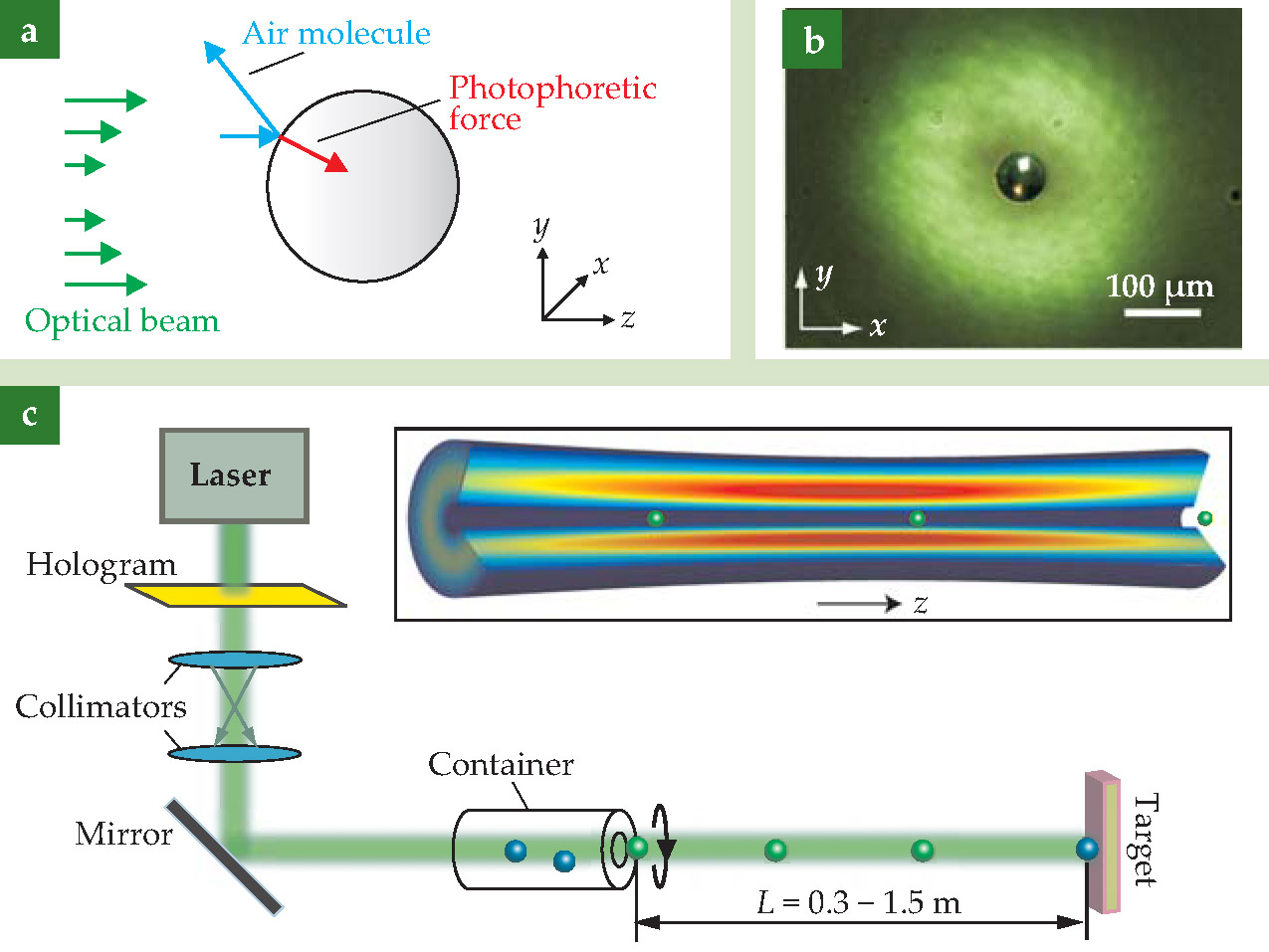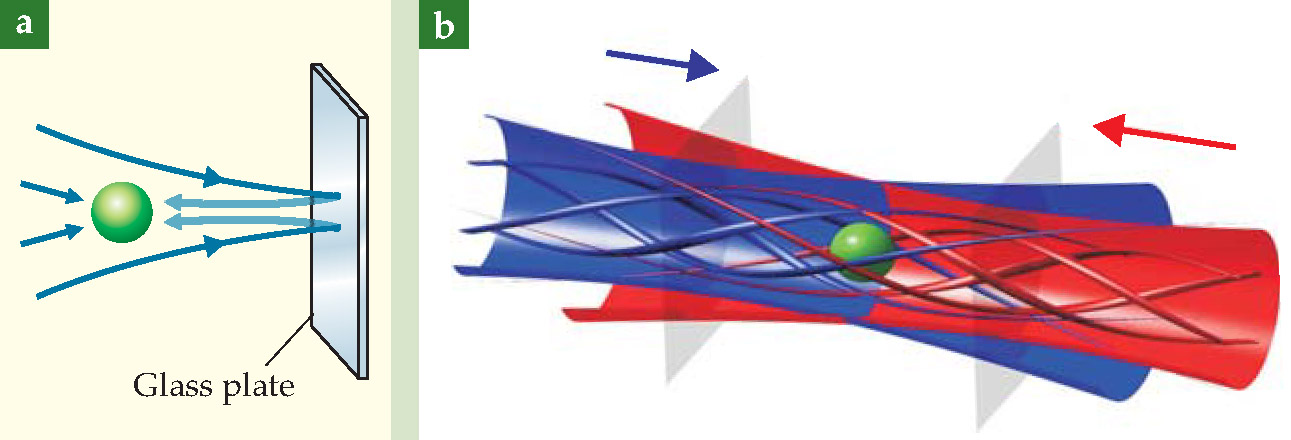Optical manipulation of light-absorbing particles takes to the air
DOI: 10.1063/1.3518265
The idea that light can move matter is not new—Johannes Kepler suspected as much some 400 years ago when he noticed that the tails of comets always point away from the Sun. That suspicion was formalized in 1871 with James Clerk Maxwell’s prediction of radiation pressure—the force imparted on a body by refracted, reflected, or absorbed light—and confirmed in 1900, when Pyotr Lebedev observed the effect in experiments.
But it wasn’t until the 1970s that what is now the most widely recognizable application of optical forces came to fruition: the optical trap. Optical manipulation has since become a mainstay in science research;
1
it has been used to tug at strands of DNA (see Physics Today, January 2006, page 26
Now, Andrei Rode and colleagues at the Australian National University in Canberra have developed a new technique that uses donut-shaped optical beams to trap and manipulate light-absorbing particles in air. 2 And whereas conventional optical techniques move particles just millimeters, theirs could conceivably send a particle gliding across a room.
Putting the pressure on
Optical manipulation traces its beginnings to a 1970 experiment by Bell Labs scientist Arthur Ashkin. 3 Aiming a laser beam into a dispersion of micron-sized latex spheres in water, he found that spheres were drawn to the beam axis and then propelled along the beam away from the light source. Both motions, Ashkin convincingly argued, were a result of radiation pressure.
Because light can be viewed as a stream of momentum-possessing photons, any time it changes direction it must exert a force, the so-called radiation pressure. From that starting point, Ashkin showed that when a light ray passes from a low-refractive-index fluid like water through a high-refractive-index sphere, such as his latex particles, it refracts in such a way as to exert a pull in the transverse direction. Regions of higher intensity exert stronger pulls, and thus a Gaussian beam, with its bright core, tends to pull a sphere in toward its axis. The same momentum-conservation concept also explains the push in the propagation direction.
A decade later, joined by colleagues, Ashkin figured out that by tightly focusing the beam, he could configure the pulls, known as the gradient force, to hold a particle in place; that design would become widely known as an optical tweezer. But as ubiquitous as optical tweezers have become, they are ill suited for use with light-absorbing particles. That’s because while radiation pressure tends to pull a particle into a Gaussian beam, a second type of light-induced force—photophoresis—works to push it out.
Photophoresis converts light to mechanical energy via a chain of events: Absorbed light heats part of a particle’s surface, the molecules of a surrounding gas bounce off that part with increased kinetic energy, and the resulting imbalance in momentum exchange propels the particle away from regions of high light intensity. Even moderate light absorption can produce photophoretic forces several orders of magnitude larger than radiation-pressure forces, which renders opaque particles immune to conventional optical traps. Most researchers get around that problem the way Ashkin and his colleagues did—by using transparent particles. The technique demonstrated by Rode and company, however, puts the strong photophoretic forces to use.
Lased donuts
The key to the group’s technique was to swap the conventional Gaussian beam for a donut-shaped Laguerre-Gaussian beam, which has a high-intensity ring of light that surrounds a dark core. Scientists already knew how to use a tightly focused Laguerre-Gaussian beam to trap light-absorbing and low-refractive-index particles in liquids; such particles, effectively repelled by light, can be confined within the beam’s dark core. In the new work, however, Rode and company use slightly focused, or collimated, beams to create long optical pipelines whose photophoretic forces can confine and propel light-absorbing particles in air, as shown in figure 1.

Figure 1. Designing an optical pipeline. (a) A photophoretic force is generated when absorbed light heats a particle’s surface unevenly, causing nearby air molecules to bounce off the hot portions of the surface with increased kinetic energy. Such a force pushes a particle away from intense light. As a result, particles that find their way to the dark core of a donut-shaped Laguerre-Gaussian beam get trapped and propelled in the direction of light propagation. (b) A cross-section image shows a 50-µm carbon-coated glass sphere trapped in the dark core of a Laguerre-Gaussian beam. (c) In the Australian National University team’s experiments, a hologram converts a Gaussian beam to a Laguerre-Gaussian beam, collimating lenses adjust the focal distance, and a mirror adjusts the aim. Particles are then loaded into the beam from a rotated cylinder, transported in the beam’s dark core (see inset), and deposited at a distant target.
(Adapted from ref. 2.)

In addition to the dark-core beam, the technique calls for particles that are strongly absorbing, to produce large photophoretic forces; poorly conducting, to sustain sufficient temperature gradients; and lightweight. After proving their concept with agglomerates of carbon nanoparticles, the group found a favorable alternative in hollow glass microspheres coated with 100-nm-thick layers of graphite. With diameters ranging from 10 to 150 µm, densities of about 0.125 g cm-3, and thermal conductivities of about 0.05 W m-1 K-1, the carbon-coated spheres contained all the essential ingredients for photophoresis in a uniform, easily analyzed shape.
To load the beam, the team placed the particles into a glass cylinder, which they coaligned with the beam axis, as in figure 1. A brief rotation of the cylinder sends the particles airborne, and the beam itself acts as a selective energy barrier: Some particles lack the kinetic energy to penetrate the high-intensity ring, others have too much and pass into the ring and immediately out the other side, and the occasional particle has the right energy to enter and remain in the dark core. Once inside the beam, the particle exits the cylinder through a small outlet, guided at a leisurely pace of about 1 cm/s until it arrives at a distant target. Though their farthest trial distance was 1.5 m, the researchers suspect that targets as distant as 10 m would be within reach.
Precision placement
Practically, not only is being able to move a particle important, so is being able to stop it, suspend it, and reverse its course. The team achieved some of those goals by using a reflecting glass plate as a target against which a particle could be trapped and moved two-dimensionally, as shown in figure 2(a). Alternatively, the team was able to suspend a particle in air, away from any substrates or surfaces, by using the counterpropagating beam arrangement shown in figure

Figure 2. Two manipulation techniques. (a) Together, a Laguerre-Gaussian beam and a partially reflecting glass plate enable two-dimensional manipulation. Near the plate, the beam illuminates a particle from both the source side and the plate side, creating a trap that suspends the particle just short of the plate. The particle can be moved around the plate by redirecting the beam. (b) A beam’s light intensity wanes as it diverges beyond its focus, or beam waist. Thus a particle placed between the waists (gray planes) of two counterpropagating beams experiences a restorative force that traps it in a stable equilibrium. The particle can be moved bidirectionally by adjusting the power of either beam.
(Adapted from ref. 2.)

Together, single-beam optical guiding, single-beam trapping against a reflecting plate, and dual-beam trapping constitute a versatile toolset for touch-free particle manipulation. The precision of those manipulations, however, was what most surprised the Canberra group. The particles’ spatial fluctuations, which depend primarily on the laser beam’s divergence, varied as 10-5 times the distance from the beam source. Says Rode, “That is like shooting a bullet from a kilometer distance with centimeter accuracy.” That accuracy leads him to speculate that the technique might lend itself to the fabrication of intricate nanostructures.
If there’s a major drawback to photophoresis, it’s that the transported particles get extremely hot. Direct measurements are difficult, but the team estimates that the carbon particles likely reach temperatures anywhere between 60 and 300 °C. Although those temperatures would rule out most biological applications, Rode and others are wasting little time dreaming up other potential uses.
One area that could benefit, speculates Jonathan Reid of Bristol University in the UK, is atmospheric chemistry. Scientists have recently developed optical traps that allow them to carefully study the behavior of liquid aerosol particles, but they don’t yet have at their disposal an analogous way to isolate absorbing particles such as carbon soot. “It’s widely expected that atmospheric black carbon soot leads to warming,” says Reid. “This work could provide an opportunity to study soot particles in a very controlled way and understand how they behave in the atmosphere.’
References
1. D. McGloin, Philos. Trans. R. Soc. A 364, 3521 (2006)
J. E. Molloy, M. J. Padgett, Contemp. Phys. 43, 241 (2002). https://doi.org/10.1080/001075101101160512. V. G. Shvedov, et al., Phys. Rev. Lett. 105, 118103 (2010) https://doi.org/10.1103/PhysRevLett.105.118103
V. G. Shvedov, et al., Opt. Express 17, 5743 (2009). https://doi.org/10.1063/1.8812393. A. Ashkin, Phys. Rev. Lett. 24, 156 (1970). https://doi.org/10.1103/PhysRevLett.24.156
